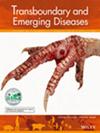Prevalence of Nonpathogenic Avibacterium paragallinarum in Naïve-Healthy Layer Flocks Across Multiple States in the United States
Abstract
Infectious coryza (IC) caused by Avibacterium paragallinarum (AP) is an emerging infectious respiratory disease in the commercial chicken layer industry in the Midwestern US states. Outbreak investigations around positive index cases led to the discovery of nonpathogenic AP (npAP), which caused quantitative real-time PCR (qPCR) positive results in naïve-healthy layer (NHL) flocks. Therefore, the reliability of positive qPCR as confirmed diagnosis of IC became questionable and the poultry industry was deprived from an essential diagnostic tool in the face of an actively spreading outbreak. However, the prevalence of npAP in NHL flocks and the magnitude of this diagnostic challenge remained unclear. This pilot surveillance study aims to provide an initial estimate of npAP prevalence in the US commercial layer industry. Two differential qPCR assays were recently developed to differentiate pathogenic AP (pAP) and npAP. A total of 710 oropharyngeal (OP) swab pools (5 swabs/pool) were collected from 80 NHL sites across 13 US states and tested using qPCR assay targeting the recN gene as a screening test. Two hundred thirty-one out of 710 total pools were positive for npAP (32.5%) representing 28 positive sites out of the 80 total sites (35%). All positive qPCR samples from NHL flocks were confirmed to be due npAP. The differential qPCR was capable of confirming 85.71% of the npAP cases, while the remaining cases required further isolation and whole-genome sequencing (WGS). In conclusion, this pilot study indicates that the prevalence of npAP in NHL flocks in the United States is above 30%. Therefore, in flocks with no clinical signs, qPCR assays cannot be relied upon for IC diagnostic confirmation. Currently, isolation combined with WGS is the only diagnostic tool capable of completely differentiating between these two AP populations, which indicates the immediate need for improvements in the available diagnostic assays.

 求助内容:
求助内容: 应助结果提醒方式:
应助结果提醒方式:


